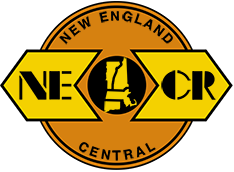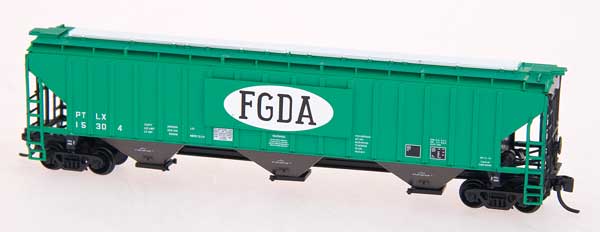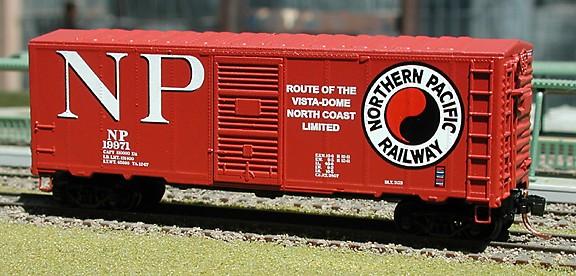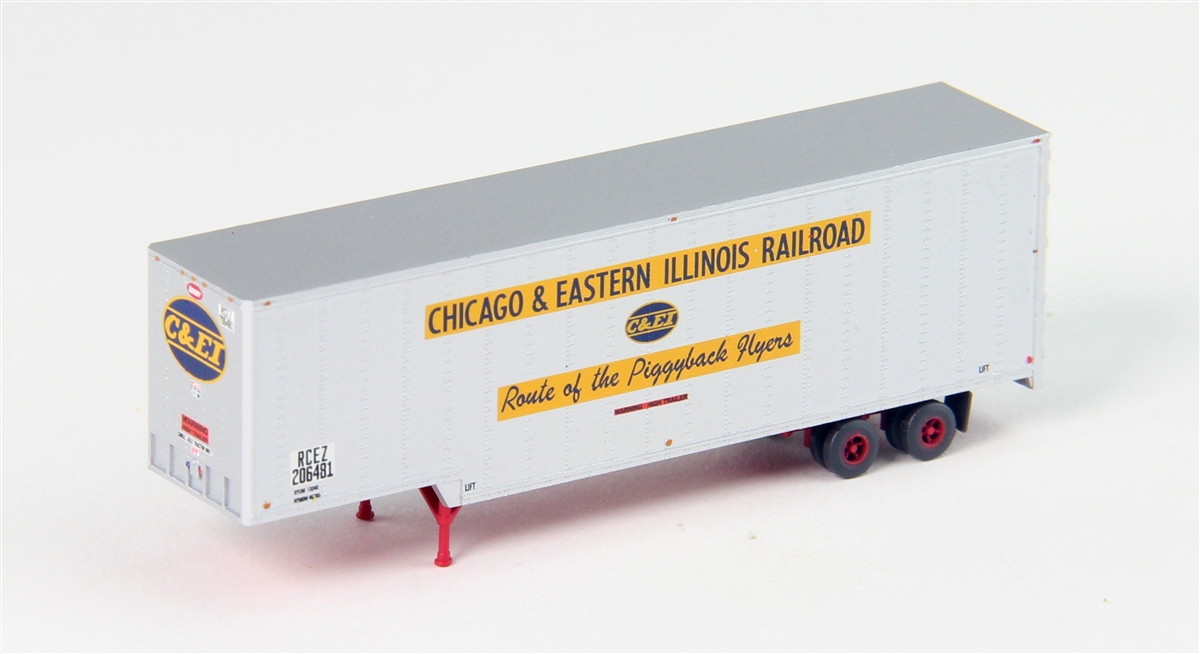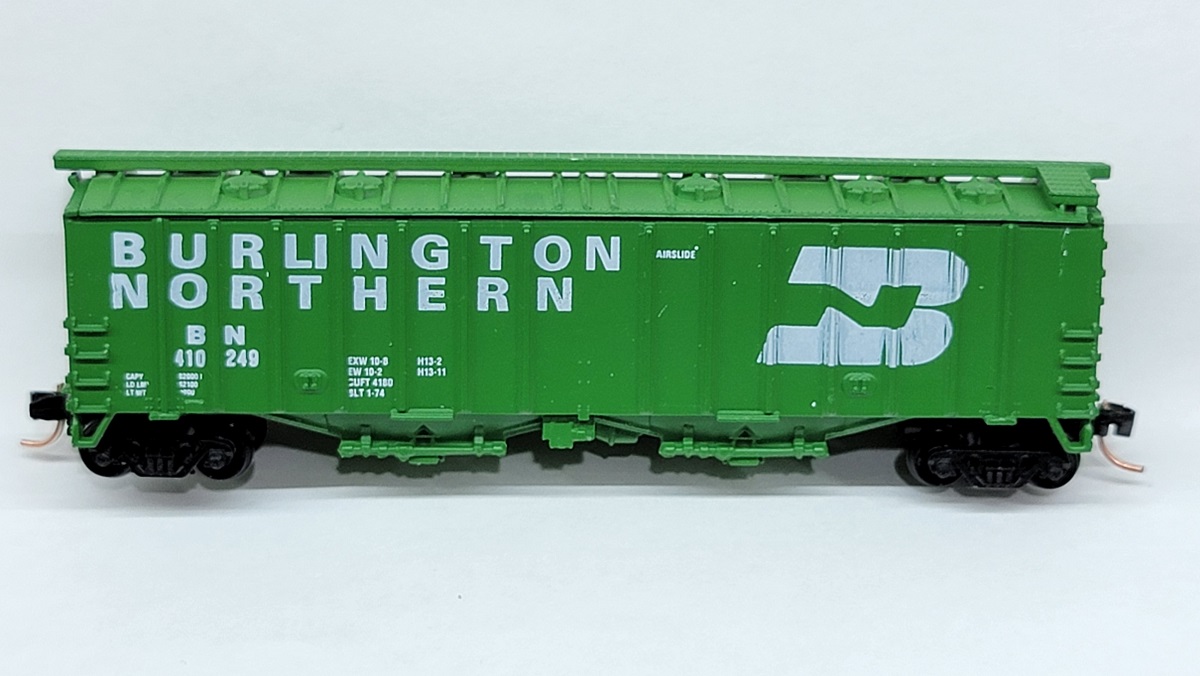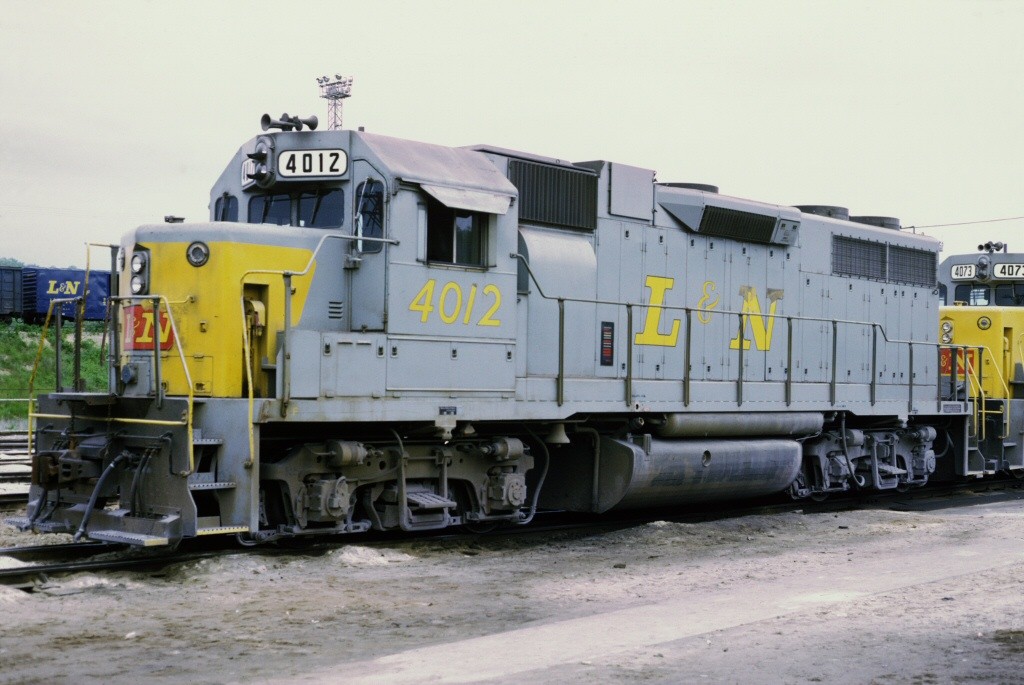Specific Item Information: Box marked CTRL (for Central)
Model Information: The Atlas GP38 is made in China and has always been made in China. These mechanisms run fine but the first releases (1996) do not support drop in decoders. Both versions use a dual-flywheel, split frame chassis with a 5-Pole skew-wound motor.
DCC Information: Early Chinese versions are DCC-friendly requiring a complicated split-board DCC install. Later versions are DCC-Ready accepting a 1 Amp N Scale Mobile Decoder for Atlas N-Scale GP40-2, U25B, SD35, Trainmaster, B23-7 and others (DN163A0) from digitrax.com. Unfortunately, the only way to tell which kind you have is to remove the shell and check the chassis. If it has two small lightboards, you have an old one in your hand. A single long lightboard indicates a DCC-Ready chassis.
As of the 2001 run, this model was also offered with factory-installed DCC decoder, first Lenz LE063XF and then (circa 2010s) a NCE decoder.
Since the 2018 run, it is only offered with ESU Loksound sound decoder without DCC no-sound option. So if you want a DCC no-sound, you'll need to install a decoder by yourself.
As of the 2001 run, this model was also offered with factory-installed DCC decoder, first Lenz LE063XF and then (circa 2010s) a NCE decoder.
Since the 2018 run, it is only offered with ESU Loksound sound decoder without DCC no-sound option. So if you want a DCC no-sound, you'll need to install a decoder by yourself.
Prototype History: The EMD GP38 is a 4-axle diesel-electric locomotive built by General Motors Electro-Motive Division between January 1966 and December 1971. The locomotive's power was provided by an EMD 645 16-cylinder engine which generated 2,000 horsepower (1.49 MW). The company built 706 GP38s for North American railroads. In 1972, it was replaced by an updated model, the GP38-2.
From Wikipedia
From Wikipedia
Road Name History: New England Central was born in 1995 when Canadian National sold the Central Vermont to RailTex. RailTex renamed the line New England Central. In 2000, RailTex was purchased by RailAmerica which has since been combined with the Genesee & Wyoming shortline group.
NECR runs 394 miles of track from East Alburgh, Vermont on the Canadian border just south of Montreal south down the length of Vermont, through Massachusetts, to the port of New London, Connecticut. Along the way, they interchange with CN, Pan Am, Norfolk Southern, Vermont Railway, Canadian Pacific, CSX, Green Mountain, Central Maine & Quebec (recently acquired by CP,) Providence & Worcester and several shortlines.
Traffic includes animal feed, chemicals, compressed gas, construction debris, foodstuffs, fuel oil, lumber, machinery, metals, newsprint and other paper, plywood, poles, recyclables, resins, salt, and vehicles. In addition to mixed manifest traffic, NECR provides intermodal service from the Canadian border to the connection with Providence & Worcester at Willimantic, Connecticut. Between 35 and 45 EMD locomotives work the line (Genesee & Wyoming moves locomotives between their various properties as traffic patterns evolve.)
NECR runs 394 miles of track from East Alburgh, Vermont on the Canadian border just south of Montreal south down the length of Vermont, through Massachusetts, to the port of New London, Connecticut. Along the way, they interchange with CN, Pan Am, Norfolk Southern, Vermont Railway, Canadian Pacific, CSX, Green Mountain, Central Maine & Quebec (recently acquired by CP,) Providence & Worcester and several shortlines.
Traffic includes animal feed, chemicals, compressed gas, construction debris, foodstuffs, fuel oil, lumber, machinery, metals, newsprint and other paper, plywood, poles, recyclables, resins, salt, and vehicles. In addition to mixed manifest traffic, NECR provides intermodal service from the Canadian border to the connection with Providence & Worcester at Willimantic, Connecticut. Between 35 and 45 EMD locomotives work the line (Genesee & Wyoming moves locomotives between their various properties as traffic patterns evolve.)
Brand/Importer Information: In 1924 Stephan Schaffan, Sr. founded the Atlas Tool Company in Newark, New Jersey. In 1933 his son, Stephan Schaffan, Jr., came to work for his father at the age of sixteen. Steve Jr. built model airplanes as a hobby and frequented a local hobby shop. Being an enterprising young man, he would often ask the owner if there was anything he could do to earn some extra spending money. Tired of listening to his requests, the hobby-store owner threw some model railroad track parts his way and said, "Here, see if you can improve on this".
In those days, railroad modelers had to assemble and build everything from scratch. Steve Jr. created a "switch kit" which sold so well, that the entire family worked on them in the basement at night, while doing business as usual in the machine shop during the day.
Subsequently, Steve Jr. engineered the stapling of rail to fiber track, along with inventing the first practical rail joiner and pre-assembled turnouts and flexible track. All of these products, and more, helped to popularize model railroading and assisted in the creation of a mass-market hobby. The budding entrepreneur quickly outgrew the limitations of a basement and small garage operation. Realizing they could actually make a living selling track and related products, Steve and his father had the first factory built in Hillside, New Jersey at 413 Florence Avenue in 1947. On September 30, 1949, the Atlas Tool Company was officially incorporated as a New Jersey company.
In 1985, Steve was honored posthumously for his inventions by the Model Railroad Industry Association and was inducted into the Model Railroad Industry Hall of Fame in Baltimore, Maryland. In addition, Steve was nominated and entered into the National Model Railroad Association Pioneers of Model Railroading in 1995.
In the early 1990s, the Atlas Tool Company changed its name to Atlas Model Railroad Company, Inc.
In those days, railroad modelers had to assemble and build everything from scratch. Steve Jr. created a "switch kit" which sold so well, that the entire family worked on them in the basement at night, while doing business as usual in the machine shop during the day.
Subsequently, Steve Jr. engineered the stapling of rail to fiber track, along with inventing the first practical rail joiner and pre-assembled turnouts and flexible track. All of these products, and more, helped to popularize model railroading and assisted in the creation of a mass-market hobby. The budding entrepreneur quickly outgrew the limitations of a basement and small garage operation. Realizing they could actually make a living selling track and related products, Steve and his father had the first factory built in Hillside, New Jersey at 413 Florence Avenue in 1947. On September 30, 1949, the Atlas Tool Company was officially incorporated as a New Jersey company.
In 1985, Steve was honored posthumously for his inventions by the Model Railroad Industry Association and was inducted into the Model Railroad Industry Hall of Fame in Baltimore, Maryland. In addition, Steve was nominated and entered into the National Model Railroad Association Pioneers of Model Railroading in 1995.
In the early 1990s, the Atlas Tool Company changed its name to Atlas Model Railroad Company, Inc.
Item created by: Powderman on 2021-12-13 18:55:01
If you see errors or missing data in this entry, please feel free to log in and edit it. Anyone with a Gmail account can log in instantly.
If you see errors or missing data in this entry, please feel free to log in and edit it. Anyone with a Gmail account can log in instantly.




